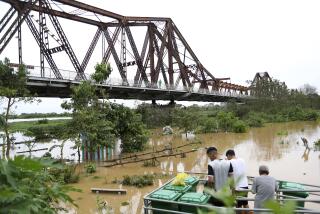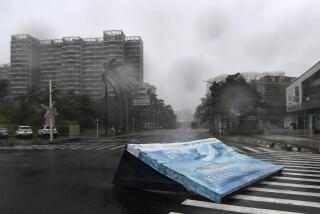‘It Was Like the Sky Was Falling In’
- Share via
KIM LIEN, Vietnam — “The mountain came down at 2 in the morning,” recalled Dinh Thi Danh, who lives in this village in central Vietnam. “It was Bam! Bam! Bam!--like the sky was falling in or the Americans were bombing. My shop just disappeared. If I’d been in it, I’d be dead now.”
Tumbling boulders had torn through the bamboo hut where she sold soft drinks and cigarettes.
“This is my only property now,” she said, lifting rocks to salvage what she could and filling a plastic basket with empty cola bottles and some dishcloths.
Comparable scenes were repeated throughout this region Sunday, as one of its great floods of the century rampaged, turning towns and villages into inaccessible islands and severing the rail line and main national highway that link Hanoi with Ho Chi Minh City.
Officials said a weeklong deluge of rain had claimed more than 450 lives--mostly in and around the old imperial city of Hue--destroyed 116 bridges and washed 6,700 houses out to sea. The International Committee of the Red Cross appealed for help, saying upward of 1 million people were in need of food, medicine and blankets.
“This is the flood of the century, a real catastrophe,” said Marshall Silver of the United Nations’ Disaster Management Unit in Hanoi. “Unlike with a typhoon, there was no warning. Just heavy rain, then floods roaring out of the mountains.”
The Perfume River in Hue crested 3 feet higher than previously recorded and left the city--the site of one of the biggest battles of the Vietnam War, in 1968--under 6 feet of water. The airport was closed, and relief workers delivered emergency food by boat.
In nearby Hoa Phu, 17 people were killed when raging currents uprooted a house and carried it down a mountainside. Around Da Nang, in Kim Lien village and other hamlets, 31 people had drowned and 14 remained unaccounted for. In Hoi An, a popular tourist town south of Da Nang, tour guide Tran Quoc Cong put his group in a rowboat and pulled it through the streets.
“I haven’t seen a flood like this since 1964,” Cong said. “I was just a little boy then, but I remember helicopters had to bring us food. They were American helicopters flown by American advisors. Times change.”
Most international relief agencies praised the government’s quick response to the crisis. With the army mobilized for the first time during a natural disaster, emergency food and medicine were being delivered by helicopter even before the rivers crested, and government ministers were on the scene, making recovery plans and providing funds to those who had lost their homes.
Central Vietnam is no stranger to typhoons and floods--the flood in 1964 killed 10,000 people--and the tropical depression that pushed inland last Monday from the South China Sea seemed neither unusual nor particularly ominous.
But it met a cold front coming down from China and stalled over Highway 1, the main north-south thoroughfare linking Vietnam’s two major cities. In some areas, 40 inches of rain fell in four days. The land became a saturated sponge that could absorb no more water. Rivers overflowed their banks, and mountain streams turned into cascading waterfalls.
The areas around Da Nang and Hue are similar to the Los Angeles Basin, enclosed between mountains and the sea. But unlike in the Santa Monica Mountains, the water that flows out of the Truong Son range encounters few flood controls, and everything in its path is imperiled.
On the 1,500-foot-high Hai Van Pass between Da Nang and Hue, Highway 1 was cut by landslides in 30 places. Two of the nine tunnels between the two cities were blocked by silt, and service was suspended on the seven daily trains between Hanoi and Ho Chi Minh City, the former Saigon.
“We’ve been here working around the clock for five days,” Trinh Huong said Sunday as his bulldozer pushed mud, boulders and uprooted trees over a cliff and into the sea. “The company sends up instant noodles, and we sleep in the culvert.”
The rain in central Vietnam on Sunday was no more than a drizzle. The Perfume and other rivers appeared to have crested. Relief workers in boats and helicopters pushed into localities outside Da Nang and Hue to assess emergency needs and the huge cleanup task that lies ahead.
“Maybe now we can be on our way before long,” said Mien Van Lan, one of 300 people who had lived for a week at the Da Nang train station, eating three meals a day supplied by railroad officials.
More to Read
Sign up for Essential California
The most important California stories and recommendations in your inbox every morning.
You may occasionally receive promotional content from the Los Angeles Times.













